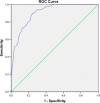Psychometric evaluation of the Lebanese Arabic version of the Dental Fear Survey: a cross-sectional study
- PMID: 34922500
- PMCID: PMC8683824
- DOI: 10.1186/s12903-021-02015-y
Psychometric evaluation of the Lebanese Arabic version of the Dental Fear Survey: a cross-sectional study
Abstract
Background: Dental fear is a prevalent problem that can lead to poor dental health. The Kleinknecht's Dental Fear Survey (DFS) is one of the used scales to assess dental fear. The present study aims to evaluate the psychometric properties of the Lebanese Arabic version of the DFS (DFS-A) and to determine the optimal cut-off to identify dental fear as well as the correlates of dental fear in a group of Lebanese adults dental patients.
Methods: A cross-sectional study was conducted among a group of 442 dental patients (18-65 years) recruited at 29 dental clinics from March to June 2019. Patients completed a questionnaire including questions about demographic characteristics, previous bad dental experience, trauma's experience period, the sensation of nausea during dental treatment, the DFS-A scale, the Lebanese Arabic version of the Modified Dental Anxiety Scale (MDAS-A), and a general question about dental fear.
Results: DFS-A revealed evidence of adequate psychometric properties. DFS-A scale demonstrated high internal consistency (cronbach's alpha = 0.93). Test-retest reliability assessment demonstrated strong reproducibility of the DFS-A scale score (ICC = 0.92 with 95% CI (0.83-0.96), p value < 0.0001 (N = 30). Confirmatory factor analysis revealed a three-factor structure of the DFS-A reflecting fear associated with specific dental stimuli and procedures, patterns of dental avoidance and anticipatory anxiety, and physiologic arousal during dental treatment. A significant correlation was found between DFS-A and the MDAS-A indicating a good convergent validity. The optimal cut-off point to identify patients with and without dental fear is 41. Considering this cut-off score, the prevalence of dental fear in our sample was reported at 33.8%. Multivariable analysis showed that having previous scary and painful dental experiences, a sensation of nausea during treatment, and having dental anxiety were identified as predictors of dental fear.
Conclusion: The adapted Arabic version of the DFS (DFS-A) is a valid tool to evaluate dental fear among Lebanese adult patients.
Keywords: Arabic version; DFS; Dental Fear Survey; Lebanese; Psychometric properties.
© 2021. The Author(s).
Conflict of interest statement
The authors declare that they have no competing interests.
Figures
Similar articles
-
Assessment of dental anxiety and dental phobia among adults in Lebanon.BMC Oral Health. 2021 Feb 4;21(1):48. doi: 10.1186/s12903-021-01409-2. BMC Oral Health. 2021. PMID: 33541354 Free PMC article.
-
Validation of Arabic version of the Modified Dental Anxiety Scale (MDAS) and Kleinknecht's Dental Fear Survey Scale (DFS) and combined self-modified version of this two scales as Dental Fear Anxiety Scale (DFAS) among 12 to 15 year Saudi school students in Riyadh city.J Int Soc Prev Community Dent. 2019 Nov 12;9(6):553-558. doi: 10.4103/jispcd.JISPCD_196_19. eCollection 2019 Nov-Dec. J Int Soc Prev Community Dent. 2019. PMID: 32039074 Free PMC article.
-
The Reliability and Validity of the Japanese Version of the Modified Dental Anxiety Scale among Dental Outpatients.ScientificWorldJournal. 2020 May 1;2020:8734946. doi: 10.1155/2020/8734946. eCollection 2020. ScientificWorldJournal. 2020. PMID: 32410911 Free PMC article.
-
Appraisal of dental anxiety and fear questionnaires: a review.Community Dent Oral Epidemiol. 1993 Dec;21(6):329-39. doi: 10.1111/j.1600-0528.1993.tb01095.x. Community Dent Oral Epidemiol. 1993. PMID: 8306609 Review.
-
Exploring the Variations in the Use of Modified Dental Anxiety Scale (MDAS) in Literature: A Survey of Studies Published from 2014 to 2023.Clin Exp Dent Res. 2024 Dec;10(6):e70040. doi: 10.1002/cre2.70040. Clin Exp Dent Res. 2024. PMID: 39535365 Free PMC article. Review.
Cited by
-
Validity and Reliability of the Vietnamese Version of the Dental Fear Survey.Int Dent J. 2023 Apr;73(2):311-318. doi: 10.1016/j.identj.2022.07.009. Epub 2022 Sep 25. Int Dent J. 2023. PMID: 36167609 Free PMC article.
-
Validation of the "obturator functioning scale" for Chinese-speaking patients with obturator prostheses after cancer-related maxillectomy.Heliyon. 2024 May 11;10(10):e31071. doi: 10.1016/j.heliyon.2024.e31071. eCollection 2024 May 30. Heliyon. 2024. PMID: 38803891 Free PMC article.
-
Dental anxiety among students in Indonesia: the role of demographic, behavioral, social, and spiritual support.BMC Oral Health. 2025 Jun 4;25(1):908. doi: 10.1186/s12903-025-06287-6. BMC Oral Health. 2025. PMID: 40468237 Free PMC article.
References
MeSH terms
LinkOut - more resources
Full Text Sources
Research Materials



